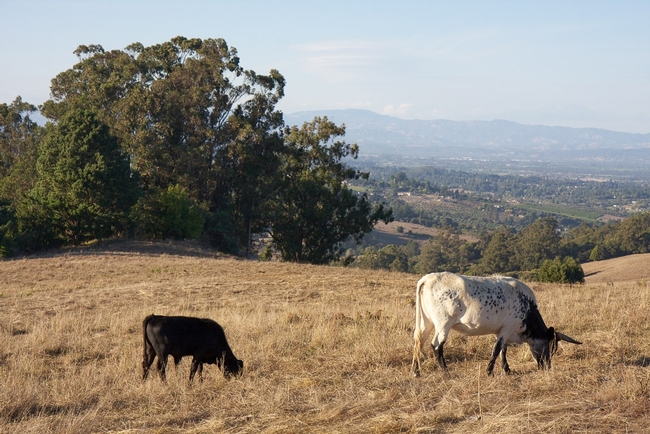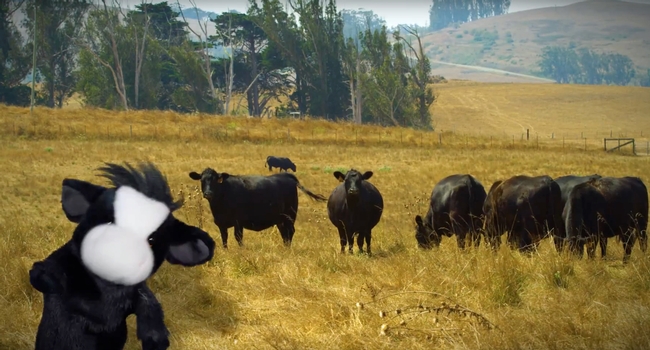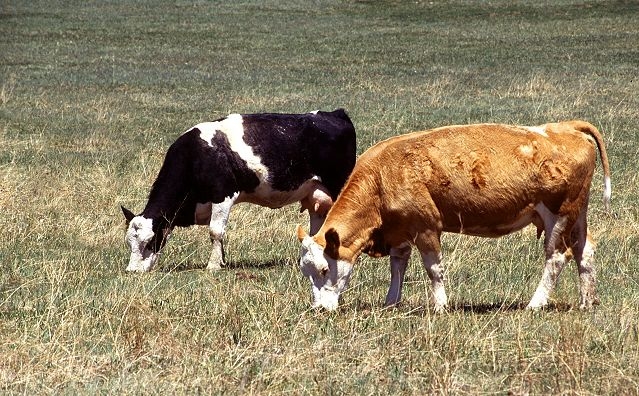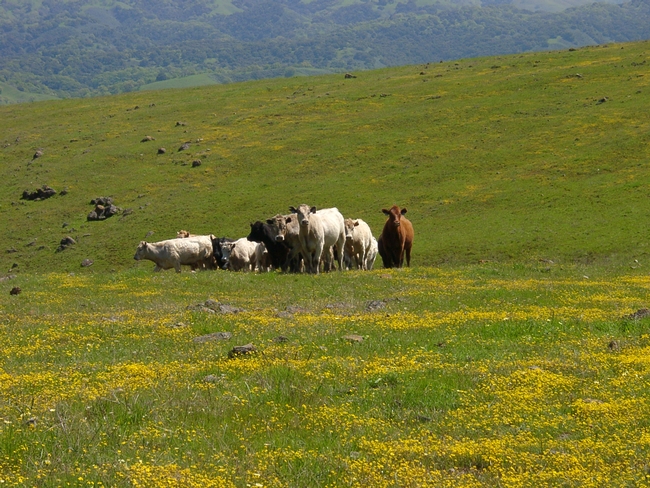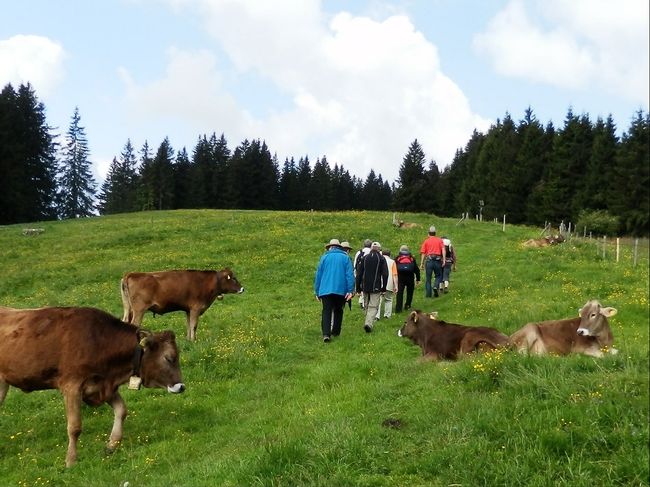Posts Tagged: Sheila Barry
Cattle grazing is a tool for reducing fire danger
Cattle can help reduce wildfire danger by grazing on fine fuels in rangeland and forest landscapes, reported Sierra Dawn McClain in Capital Press. The article also appeared in the Blue Mountain Eagle, the Westerner and the East Oregonian.
The article cited the preliminary results of research by UC Cooperative Extension that show that cattle consumed approximately 12.4 billion pounds of forage across California in 2017. The researchers believe the cattle could do more.
Many grazable acres aren't grazed, said Sheila Barry, UCCE livestock and natural resources advisor in Santa Clara, San Mateo, Alameda and Contra Costa counties. According to the Capital Press article, Barry said the public doesn't always recognize the benefits of grazing; they see short grass and cow patties. Cattle's role in preventing wildfires is often overlooked.
Devii Rao, UCCE livestock and natural resources advisor for San Benito, Monterey and Santa Cruz counties and the study's lead, said ranchers should target grazing around homes, infrastructure, roadsides and at the wildland-urban interface.
“There are so many things we can do better. Cattle grazing is really important to fire safety, and it's time we have more conversations about it,” Rao said.
Videos show hikers how to avoid Black Friday stampedes on park trails
While Americans traditionally beat a path to the malls the day after Thanksgiving, many opt out of shopping on Black Friday to enjoy the outdoors. In regional parks and other open spaces, hikers may encounter crowds of a different sort – cattle grazing with their calves. A 1,200-pound cow blocking the path can be daunting.
With a little patience and understanding, people who hike, bike and horseback ride can coexist peacefully with the cattle, according to Sheila Barry, UC Cooperative Extension livestock and natural resources advisor in Santa Clara County.
For happier trails, UC Agriculture and Natural Resources has produced a series of videos that show hikers how they can amicably share open space with their beefy neighbors. In a two-minute video, a black cow puppet with a furry white face describes how to politely coax cows to moo-ove aside without spurring a Black Friday stampede.
“We wanted to produce videos that are entertaining as well as informative,” Barry said.
The cow pun-filled video also describes the ecosystem services cattle provide by consuming nearly their body weight in plants. By grazing, cows manage the vegetation, reducing wildfire fuel, increasing water capture and promoting the diversity of native grasses and wildflowers.
In “Sharing open spaces with livestock,” the UC Agriculture and Natural Resources livestock experts give four simple tips for safely sharing open space with cows on the trail:
- Keep moo-ving and speak in a normal tone. Sudden movements and loud noises may surprise cows.
- Approach cows from the side or front. They find it udderly unnerving to have someone sneak up from behind, the bovine blind spot.
- Steer clear of getting between a protective mother and her calf.
- If you need to move a cow, step slowly into its flight zone. Invading the animal's “personal space” will motivate it to mosey aside.
A second video, “Sharing open spaces with livestock when you have a dog,” gives advice for dog owners to keep their best friends safe around cows.
In a third video, “A year in the life of a cow,” the UC Cooperative Extension spokespuppet describes a typical year for a beef cow.
“The videos are a fun way to educate the public about grazing on rangelands,” said Stephanie Larson, UC Cooperative Extension livestock and rangeland advisor in Sonoma County.
The videos are based on the UC ANR publication “Understanding Working Rangelands,” authored by Barry and Larson, at http://ucanr.edu/shareopenspace.
Watch all three videos on UC ANR's YouTube channel:
Sharing open spaces with livestock https://youtu.be/Qd8LEGLDhaM
Sharing open spaces with livestock when you have a dog https://youtu.be/zzdGnfFwmcA
A year in the life of a cow https://youtu.be/znJbWknVXVg
Impact of grazing livestock on public lands under drought conditions
Poor management of grazed rangelands can "exacerbate the effect of drought," the report said.
The Forest Service identified the need to reduce cattle numbers on public land during a severe drought - in come cases to 50 or 70 percent of total carrying capacity, which is the number of animals the land can support before causing environmental degradation. Plants that have been overgrazed "are less able to recover after a drought," the report said.
For expert commentary, Danovich turned to a UC Agriculture and Natural Resources (UC ANR) source. Sheila Barry, the livestock and natural resources advisor for UC ANR Cooperative Extension, said ranchers do have to reduce herd size in times of extreme drought.
Cattle that graze on the open range are usually finished at a feed lot. In the first year of drought, ranchers have the option of weaning cattle early to reduce demands on the land without reducing the herd size. In the second year of drought, ranchers have to consider cutting into their herds. "As soon as they do that," Barry said, "it can take up to eight years to build it back."
Grazing is good for public lands
The author, Sheila Barry, the natural resources and livestock advisor for UC ANR Cooperative Extension in the Bay Area, wrote that overgrazing and impacts to riparian woodlands are legitimate concerns, but have been effectively addressed with modern range management practices. Ranchers can minimize harmful impacts by maintaining proper stocking rates, creating riparian pastures, limiting grazing in sensitive areas and adding off-stream water sources.
Barry delineated a series of beneficial impacts of cattle grazing on Bay Area parklands. She said grazing minimizes wildfire hazards, manages non-native annuals, prevents thatch build up, promotes flowering plants, and improves carbon sequestration.
Barry added that no documented plant or animal species extinction has been linked to cattle grazing in California. On the contrary, numerous threatened and endangered species rely on grazing and rancher stewardship, including Santa Cruz tar plant, Contra Costa goldfields, Sonoma spineflower, San Joaquin kit fox, California tiger salamander, California red-legged frog, Ohlone tiger beetle, and Bay checkerspot and Callippee silverspot butterflies.
The magazine also included a "con" argument, written by Karen Klitz, a member of the Western Watersheds Project board of directors, and Jeff Miller, a conservation advocate with the Center for Biological Diversity and director of the Alameda Creek Alliance. The authors say grazing is incompatible with conservation because damage wrought by livestock is not a thing of the past. Klitz and Miller cite research showing that removing cattle can restore trout populations, native songbirds, wildflowers and amphibians. Grazing cessation at Mount Diablo State Park decreased weedy species and increased native grassland species and supports 16 rare or endangered wildlife species, the article said.
People and cattle can share open space
When a hiker on a San Francisco Bay Area parkland unknowingly walked between a cow and her calf, the mother came over, knocked the hiker down and stepped on him. In another incident, a woman walking her dogs off leash was chased by cows. She slipped and sprained an ankle.
Such incidents, though rare, prompted UC Agriculture and Natural Resources (UC ANR) experts to write guidelines for people who hike, cycle or ride horses in natural areas where grazing cattle are used to manage the land. The four-page publication, Sharing Open Space: What to Expect from Grazing Livestock, is available for free download from the UC ANR online catalog.
“Areas that were traditionally rangelands, especially in urban counties, are more and more often becoming parklands,” said Stephanie Larson, UC ANR Cooperative Extension livestock advisor in Sonoma County and lead author of the publication. “State parks generally remove grazing, but we didn't want to see that at regional and county parks.”
Cattle grazing can provide important services to these working landscapes, like managing the vegetation, reducing fire hazards, increasing water capture, and promoting the diversity of plant. With education, Larson believes, people who hike, bike and horseback ride can coexist peacefully with the cattle.
Cattle may seem intimidating because of their size, but they are vulnerable to attack by coyotes and other predators. As prey animals, cows naturally experience and express fear and protective behavior, especially when unfamiliar people and animals are near and to protect their young.
Cattle can feel threatened by dogs, which they will perceive as predators. The guidelines recommend keeping dogs close and under complete control at all times. Just like people, dogs should never get between a cow and her calf.
The guidelines detail typical cattle posture when relaxed and when agitated, their response to intrusions into their personal space (or “flight zone”), and reactions to loud noises.
“Unless you need to move cattle out of your way, such as move them off a narrow trail, it's best to give them plenty of space and avoid their flight zone altogether,” the guidelines advise.
Injured cattle should be reported and left alone. The guidelines suggest people never approach a cow from behind, make quick movements or flap their arms, or try to “rescue” calves that seem to be separated from their mothers.
“The mother may be off drinking or eating, and will return to the baby,” the authors write. “She may even be watching you.”
Co-authors of the guidelines with Larson are Sheila Barry, UC ANR livestock and natural resources advisor in the Bay Area, and rangeland management consultant Lisa Bush.
An initiative to maintain and enhance sustainable natural ecosystems is part of UC Agriculture and Natural Resources Strategic Vision 2025.


